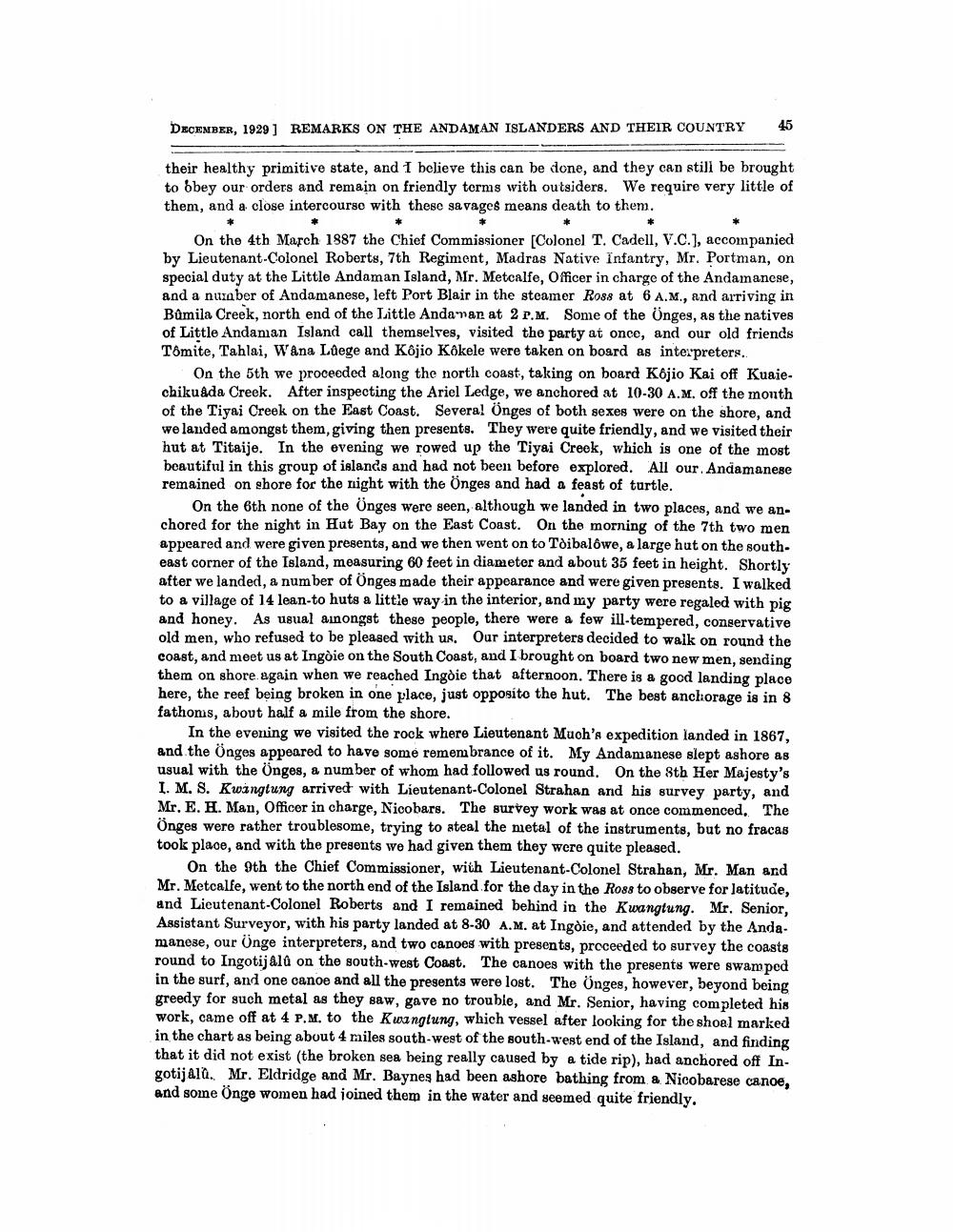________________
DECEMBER, 1929 ] REMARKS ON THE ANDAMAN ISLANDERS AND THEIR COUNTRY
45
their healthy primitive state, and I believe this can be done, and they can still be brought to bbey our orders and remain on friendly terms with outsiders. We require very little of them, and a close intercourse with these savages means death to them.
On the 4th March 1887 the Chief Commissioner (Colonel T. Cadell, V.C.), accompanied by Lieutenant-Colonel Roberts, 7th Regiment, Madras Native Infantry, Mr. Portman, on special duty at the Little Andaman Island, Mr. Metcalfe, Officer in charge of the Andamanese, and a nuzaber of Andamanese, left Port Blair in the steamer Ross at 6 A.M., and arriving in Bûmila Creek, north end of the Little Andanan at 2 P.M. Some of the Önges, as the natives of Little Andaman Island call themselves, visited the party at once, and our old friends Tomite, Tahlai, Wana Lûege and Kôjio Kōkele were taken on board as interpreters.
On the 5th we proceeded along the north coast, taking on board Kojio Kai off Kuaiechikuada Creek. After inspecting the Ariel Ledge, we anchored at 10-30 A.M. off the month of the Tiyai Creek on the East Coast. Several Önges of both sexes were on the shore, and we landed amongst them, giving then presents. They were quite friendly, and we visited their hut at Titaije. In the evening we rowed up the Tiyai Creek, which is one of the most beautiful in this group of islands and had not been before explored. All our Andamanese remained on ghore for the night with the Önges and had a feast of turtle.
On the 6th none of the Unges were seen, although we landed in two places, and we anchored for the night in Hut Bay on the East Coast. On the morning of the 7th two men appeared and were given presents, and we then went on to Tdibalówe, a large hut on the southeast corner of the Island, measuring 60 feet in diameter and about 35 feet in height. Shortly after we landed, a number of Onges made their appearance and were given presents. I walked to a village of 14 lean-to huts a little way in the interior, and my party were regaled with pig and honey. As usual ainongst these people, there were a few ill-tempered, conservative old men, who refused to be pleased with us. Our interpreters decided to walk on round the coast, and meet us at Ingòie on the South Coast, and I brought on board two new men, sending them on shore again when we reached Ingòie that afternoon. There is a good landing place here, the reef being broken in one place, just opposite the hut. The best anchorage is in 8 fathoms, about half a mile from the shore.
In the evening we visited the rock where Lieutenant Muoh's expedition landed in 1867, and the Önges appeared to have some remembrance of it. My Andamanese slept ashore as usual with the Onges, a number of whom had followed us round. On the 8th Her Majesty's I. M. S. Kwangtung arrived with Lieutenant-Colonel Strahan and his survey party, and Mr. E. H. Man, Officer in charge, Nicobars. The survey work was at once commenced. The Önges were rather troublesome, trying to ateal the metal of the instruments, but no fracas took place, and with the presents we had given them they were quite pleased.
On the 9th the Chief Commissioner, with Lieutenant-Colonel Strahan, Mr. Man and Mr. Metcalfe, went to the north end of the Island for the day in the Ross to observe for latitude, and Lieutenant-Colonel Roberts and I remained behind in the Kwangtung. Mr. Senior, Assistant Surveyor, with his party landed at 8-30 A.M. at Ingdie, and attended by the Andamanese, our Unge interpreters, and two canoes with presents, proceeded to survey the coasts round to Ingotijalù on the south-west Coast. The canoes with the presents were swamped in the surf, and one canoe and all the presents were lost. The Onges, however, beyond being greedy for such metal as they saw, gave no trouble, and Mr. Senior, having completed his work, came off at 4 P.M. to the Kuangtung, which vessel after looking for the shoal marked in the chart as being about 4 miles south-west of the south-west end of the Island, and finding that it did not exist (the broken sea being really caused by a tide rip), had anchored off Ingotijala. Mr. Eldridge and Mr. Baynes had been ashore bathing from a Nicobarese canoe, and some Onge women had joined them in the water and seemed quite friendly.




